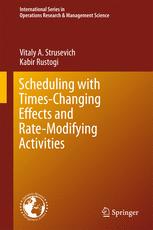

Most ebook files are in PDF format, so you can easily read them using various software such as Foxit Reader or directly on the Google Chrome browser.
Some ebook files are released by publishers in other formats such as .awz, .mobi, .epub, .fb2, etc. You may need to install specific software to read these formats on mobile/PC, such as Calibre.
Please read the tutorial at this link: https://ebookbell.com/faq
We offer FREE conversion to the popular formats you request; however, this may take some time. Therefore, right after payment, please email us, and we will try to provide the service as quickly as possible.
For some exceptional file formats or broken links (if any), please refrain from opening any disputes. Instead, email us first, and we will try to assist within a maximum of 6 hours.
EbookBell Team

4.7
66 reviewsIn scheduling theory, the models that have attracted considerable attention during the last two decades allow the processing times to be variable, i.e., to be subjected to various effects that make the actual processing time of a job dependent on its location in a schedule. The impact of these effects includes, but is not limited to, deterioration and learning. Under the first type of effect, the later a job is scheduled, the longer its actual processing time becomes. In the case of learning, delaying a job will result in shorter processing times. Scheduling with Time-Changing Effects and Rate-Modifying Activities covers and advances the state-of-the-art research in this area.
The book focuses on single machine and parallel machine scheduling problems to minimize either the maximum completion time or the sum of completion times of all jobs, provided that the processing times are subject to various effects. Models that describe deterioration, learning and general non-monotone effects to be considered include positional, start-time dependent, cumulative and their combinations, which cover most of the traditionally used models. The authors also consider more enhanced models in which the decision-maker may insert certain Rate-Modifying Activities (RMA) on processing machines, such as for example, maintenance or rest periods. In any case, the processing times of jobs are not only dependent on effects mentioned above but also on the place of a job in a schedule relative to an RMA. For most of the enhanced models described in the book, polynomial-time algorithms are presented which are based on similar algorithmic ideas such as reduction to linear assignment problems (in a full form or in a reduced form), discrete convexity, and controlled generation of options.